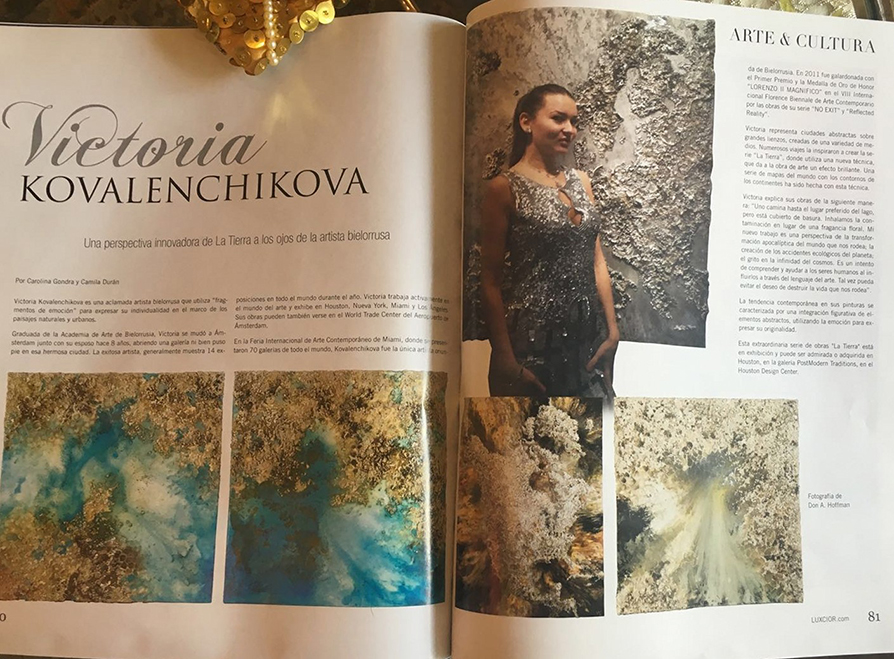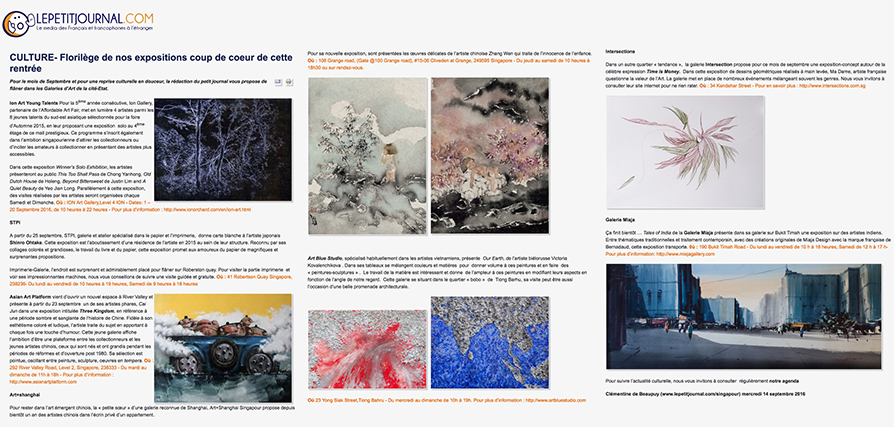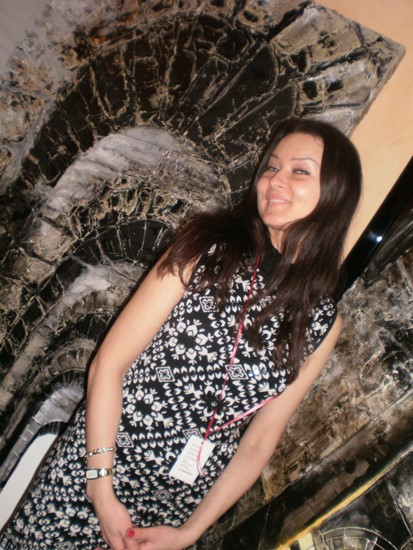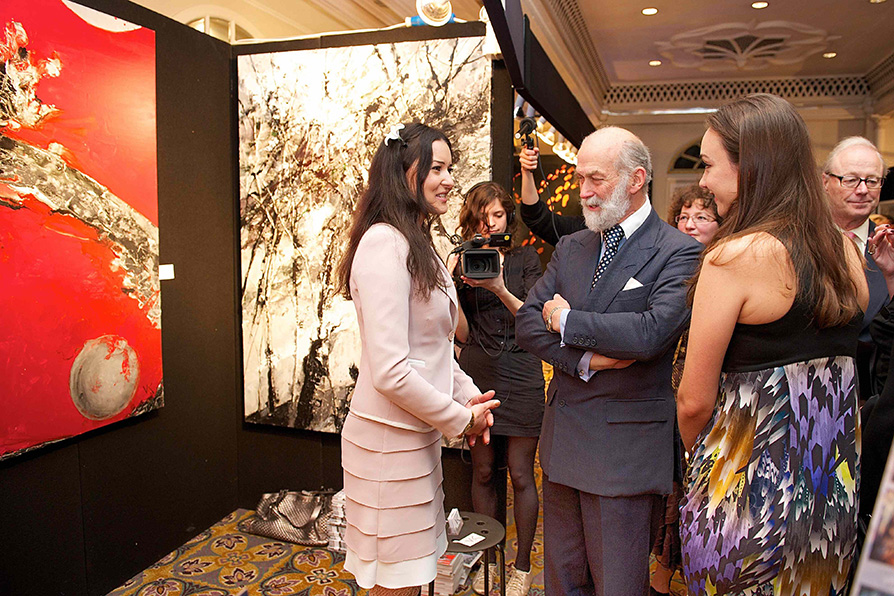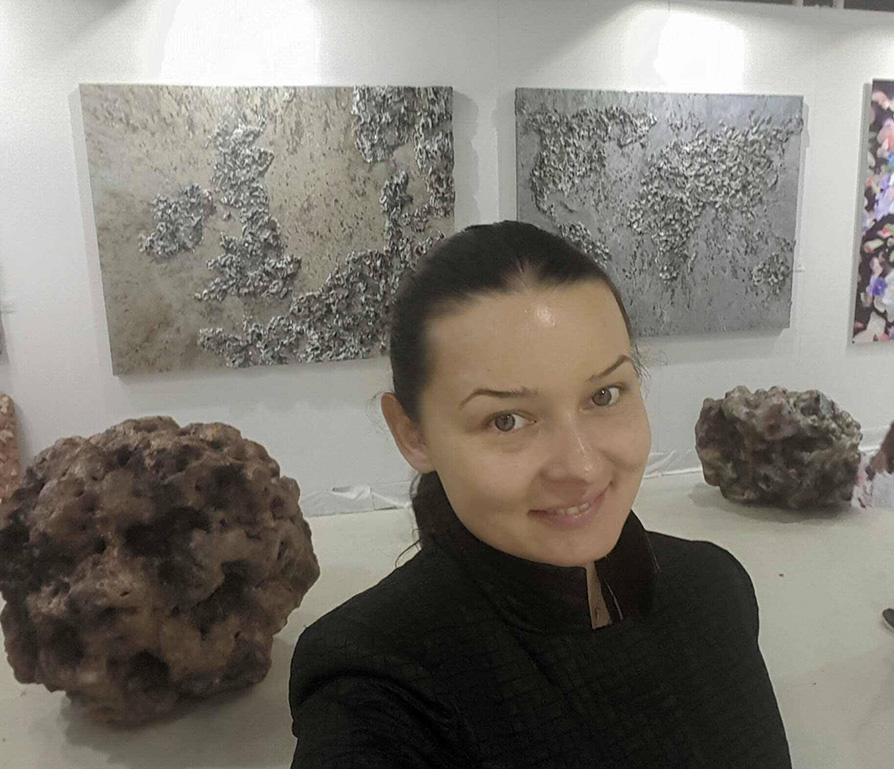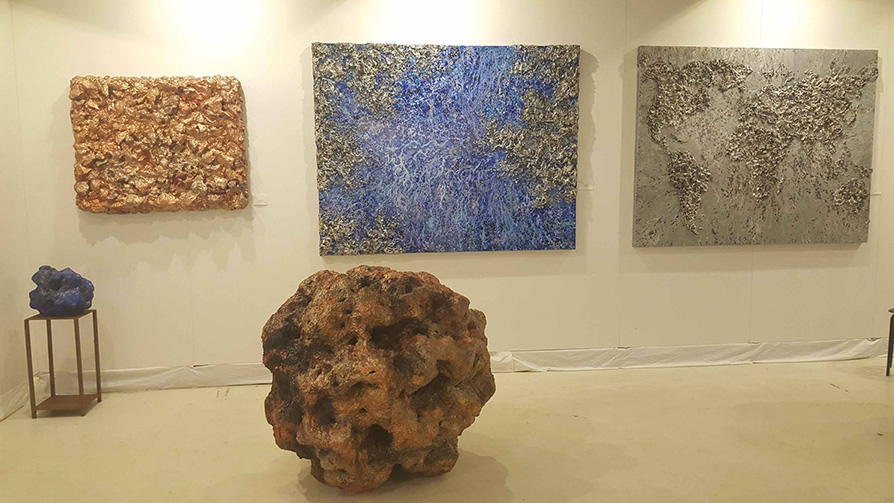 home
about
artists
exhibitions press
contact
purchase
home
about
artists
exhibitions press
contact
purchase |
|||
|
VICTORIA KOVALENCHIKOVA
Dive into the Deep End of Pool Art Fair
What’s the first thing that comes to mind when you check into a hotel – Where’s the ice machine or do they have cable? You pray that there are no bedbugs on the mattress? Maybe you just have to explore if they have a swimming pool where you can do a cannonball dive and just jump in. The Flatiron Hotel has an awesome aquarium tank of tropical fish from the lobby to the mezzanine but you can’t dive inside so instead they have the Pool Art Fair. Now this one, you can dive as deep as your senses will allow. Arte Fuse went on a Friday night, March 9, 2012 for the preview at the Flatiron Hotel, which hosted artists from all over the world and the unique part about this is that you visit the staged hotel rooms that become their mini galleries. In the wise M.O. of trekking it like you would in Guggenheim, it was best to start at the very top floor then work your way down via stairwell. Elevator activity is hectic and you can be waiting forever. Starting on the 6th floor, I entered Suite #608 and found the video art of Korean artist, Sang Ho-Shin. Chief Curator Sangmi Oh was on hand to explain the life cycle theme. There were also some paintings related to the video and the futuristic bent had me transfixed to watch a computer generated human form slowly disintegrate on one side while the other one gained more layers meaning it added life. Mortality is always a fascinating subject for artists but the slick presentation made it easy to digest an otherwise morbid theme. The delicate life never looked so chic. Taking the stairwell and going down to Suite #508 for the stylish work of Anne-Marie Cosgrove. I even thought I crashed into somebody’s actual hotel room but as it turned out her work was so suited for the bedroom. Anne-Marie said that she got lucky with minimal changes and just placing the art. The careful monochromatic approach of swirling forms turned out to be words in script but looped larger with brush strokes. There are subtle compositions and indicated objects but it seamlessly reads an overall abstract piece. I suggested that she can do all the art for the hotel rooms but she’d rather be commissioned to do a single big piece for the lobby. One time labour, maximum return! Walking down the corridor to Suite #506 for Yoshiya Homma I stopped in for his wry take on mounted art of dolls, an electric shaver and a can opener based on a late 1800’s model. He even had kits in plastic bags to take home and construct your own art. This is a clever statement on the commercialization of art. The white backing board and the text with its dictionary toned slogan gives this an edge and entertaining in concept but with the cool aesthetic to boot. Backtracking to Suite 501 for two sets of artists: J. B. Wilson shared the room with Liz-n-Val. Now this is where the fun part begins. The previous rooms were kept like hotel bedrooms embellished with art placement but now all bets are off. The mattress had been removed and there was an actual tree on it by J. B. Wilson. A tree grows inside a hotel bedroom – only in New York! How very innovative that he executed his vision with a tree growing out of the reclining bodies of the mannequins. “Tree” is his statement of resting and how life encroaches upon you if you passively opt out. Liz-n-Val had bright stripes of tape embellished all over like Prismatic rays and it provided a DIY Mod 60′s style backdrop for the art they showcased as well. The odd pairing juxtaposed boldly in that one space and it worked as one of the memorable spaces. Over a few doors down there was a cockfight going on. It’s illegal and how very subversive to have it inside a hotel room but relax folks – don’t get PETA on the artist Borinquen Gallo at Suite 507. Her handcrafted sculptures of two roosters set amidst the black cascading waves of trash bags was like a dream canopy for a Goth princess but it set the tone effectively. Coupled with her video of a simulated cockfight using her sculptures that she looped on her laptop, it’s all about the brutality of such a practice that was born out of the Roman culture of fighting to the death. Think Gladiator with ruffled feathers! Loser gets fried! On the fourth floor, we had girl power. Suite 406 was Victoria Kovalenchikova with her textured masterpieces that is massive in size. The large scale is a perfect foil for the intimate setting of the room. I’ve seen Victoria’s work at the Museum of Russian Art (MORA) in Jersey City last year. She is based in Amsterdam and this was a pleasant surprise to see her very impressive work once more. Over on Suite 401 was the “Canary in a Coal Mine “ show by Heather “Van Uxem” Lewis. She featured dark painted panel paintings and photography of herself. For the night she dressed up with a miner’s head light per the theme. Caged canaries were taken down into mines as warning devices when air supply got low – if the bird dies then the miner’s run for daylight. Van Uxem conveyed the wrenching throes and ecstasy of death in the seductive coal blackness. Finally in Suite 301 and the fitting bookend for this art fair was Gustavo Blanco-Uribe. His Brooklyn Bridge with coloured in details was chosen as the cover art for the Pool Art Fair 2012 on their fold out information brochure. His work is very precise with the added elements of colour on black-white photography then cutting clean portions in a pattern that further enhances the unique style of his multimedia images. This artist is based in Madrid and should be in the forefront of the art world real soon. I can fully support why his work was chosen to be a prominent feature for Pool Art Fair. The mysteries of the deep are immense and its hidden beauty worth exploring. Pool Art Fair at the Flatiron Hotel delivered a substantiated experience in having artists be challenged and coming up to the surface crystal clear on what their art represents. I can’t wait to dive in next year and get soaking wet! Pool Art Fair. Flatiron Hotel. Corner of 26th Street and Broadway. New York, NY Article by: Oscar A. Laluyan The Mirror. The City. The Soul. "In this space the person interested can move along the marked and unmarked roads, through existent and nonexistent lands, diving to see the bottom under the water, bending forward to discern a blade of grass which has drawn the attention, rising on tiptoe to peer at a silent cloud... Here too the rivers once were drops, and roads - footpaths...". Goran Petrovic "Sky-Locked Atlas". Art is an impartial mirror of time even when it artificially decks grey everyday life, plays with our phobias and low instincts or bathes in sugary aroma of kitsch. Our time and we are the poetisation of boredom and prosy cruelty, the philosophizing in a frantic attempt to understand at least something, melancholy, irony and pleasure at the same time. It is an artificial mirror in which both reality and its author reflects - the one who him/herself is a fragment of the surrounding world and its basis. The inner world of the creator is a splinter of the great universal mirror. But who says that we realize the creative work as a prism of the surrounding world? In reality it is hidden from us. After all the understanding is transference into another life. And is it possible to understand the thing which is not the own creation? Our subjective vision is also a reality. We read works of the creator as a page from a diary, not knowing, what this or that described detail actually meant. We do not guess at all, and only seize something that seems common for us and connected with our own memories. This is how the work and its author become the mirror for us - the audience, connoisseurs and interpreters - multitude that gives rise to the world of the human reality. Victoria Kovalenchikova's works are dedicated to the subject-matter of the city. Certainly, there are other topics in her creativity that are reflected in lyrical and rural landscapes, portraits and still lifes. However, the artist depicts the city with its quaint entwinements of building lines more often. Is the author's choice accidental? Of course, no. The language of architecture is plastic, multiple and filled with emotions. History and the contemporaneity, the essence of form and sense, an indissoluble connection of sensuality and functionality are interpreted in it. The world of architecture is a reflection on the inside and from the outside. Inside of us there are apartments, rooms and corridors where we used to walk, to sneak noiselessly out on the street to play and to rush to school. A scene from the window, a reflection of splashes in the sideboards' glasses, a groan of the door, smells. A great number of details that we remember and live with. Architecture from the outside of us is streets we used to go along in summer, a footpath through a garden, straight on, a habitual route to the work place and a favourite meeting place. The city's architecture is our soul's mirror. And its mirror. Looking at this world, the world of paintings by Victoria Kovalenchikova is seen as a reflection of her own memory and reminiscences, i.e. sounds and movements, feelings and ideas. This is what the author lives with, the way she sees and feels. This is how memory's canvas is woven. Not from newspaper cuttings, scraps of articles or journalistic news. Every canvas of Victoria Kovalenchikova is an emotion stiffened suddenly as if condensed air bound by an indivisible sigh. The title of Victoria Kovalenchikova's latest exhibition, City Rhythms, is not casual. It is a series of picturesque works where one can perceive the true, not imposed rhythm of the city in a silent contemplation of the streets' measured steps. Architecture in her works becomes a universal basis that is ready to accept any mood, idea or its echo. Architecture is understood as the world's divine fundamental principle. And the first line, the precise line of a building, in the artist's canvas turns into a beginning of the universe, it fastens and connects the whole narration. Architecture is postulated as a basis of our material and thing world. However, it is adorned by ideas, desires, feelings: and memory. "The city's larger half will disappear, the same half will appear, and then they will disappear as well, the next one appears, then disappears. Houses, long rows of houses, streets, miles of roadways, heaps of bricks and stones. Changing hands. One owner, another one: Pyramids in the sands. Built on bread with onions. Slaves built the Chinese Wall. Babylon. Huge blocks left. Round towers. Everything else is dust, inflated suburbs of an early construction. Quirvan's houses of cards where the wind searches. Only a night shelter. Anyone is nothing". James Joyce, Ulysses. This is how memory's canvas is woven: In her canvases, Victoria Kovalenchikova does not play crafty with laconism of separate details, does not make certain signs of them. She paints a situation: general, integral and full. It is not a greased, as if a dim print, photo through the glass where a muddy outline of buildings is only seen, either. The artist's architecture is a hull, basic lines for a rave of paints and shades. As if a stone, natural in its bends, is framed by a strict skeleton of silver. The city flows by Victoria Kovalenchikova's brush: her colour scale is deep and rich. Smooth and viscous as caramel, it can be tasted, savoured and tried. Slightly muffled, thin and accurate in the shades' transitions, her colour is various, containing a whole spectrum, a whole scale of emotions, without a loud opposition, without stiffness and a new-fangled hysteria of colour. Her colour reflects a condition of rest: in the twilight of a day, when the sun has impregnated the houses' walls, having filled them with an unforgettable sensation of luxury and heat. As if a lace of the sea foam, a light white veil of sputtering suddenly gives rise to a feeling of Christmas pleasure, virgin-snow cleanliness and youth. Victoria Kovalenchikova's city is young, it is full of a vital force and energy. And all-sufficient. The city and its architecture are dimensioned and strong, its emotions are more complex, intense and precise than those of people which are sprayed like a fog of senses. The city is eternal. In its history, a human being is ephemeral in spite of the fact that his hands have created magnificence of marble, stone and metal. This is how the human sea grinds the rocks of the cities' strongholds for centuries. And through their existence, people receive their pass in history. This is how they speak the language of creativity through the centuries, overcoming the borders of time, to themselves. The humankind can only live by creating in an infinity of self-knowledge of their way and applicability. What does the city mean for Victoria Kovalenchikova? It is the artist's mirror where her essence is reflected impartially. The city is she herself and her attitude to herself. Architecture for her is a notebook or, more exactly, a cabinet of curiosities in which her memory is stored. Memory is like a reflection of the most valuable for a person when the artist's creation opens to a spectator as a variant of a self-reflection. "An open art work is not an illustration to described reality but its reproduction in its own structure realized in an act of communication of the art work with an audience. "The art work's structure" turns into the cosmos's mirror: The universe we try to learn (or at least to offer comprehensible interpretations) is nothing but a "transcendental form of language". Umberto Eko, Interpretations' Paradoxes. However pompously it may sound, with the help of the canvases' eyes,
the artist looks at the unearthly things incomprehensible by
people's logic and accounting machine. Victoria Kovalenchikova opens
a picture of the world in her own picture of the city built of
multitude of memory's artefacts - subjects and connections between
them, events and associations that they create. And the artist's
each canvas is a fragment of a uniform outlook at the world.
Probably therefore she does not give any ethnographic reference
points that could precisely refer us to certain associations. Still,
we do know the artist's city. And the spectator tries to solve these
tangles of the building lines. The city and its architecture tells
us, just a moment and you shall recognize a familiar lane, a tense
string of a highway and a noisy crossroad. It seems that we have
already seen it, recognized it and remembered it. The building,
street, its turn, these roofs, ladders, windows. However, memory's
small knot slips out of our hands. Where are you, memory? What have
I seen here? And a lonely figure only smiles mysteriously on the
background of the warm squares of the buildings filled with the
sunset light.
"London
Info" #09, 17-23 December 2010 A young but distinguished artist, Victoria was born in Belarus where she studied and had her first exhibitions. Her excellent technique and expressive style quickly gained recognition. She moved to Amsterdam 2,5 years ago and made the next step - opened her gallery. Her works were recently presented in London at Art Bizarre Salon. We talked to Victoria about the vital elements of success. Did the move to the
Netherlands influence your works? How can you describe a
situation with art sphere in the Netherlands? How big is the difference
in the art education in Europe and post-Soviet countries? So self-discipline is one
the vital personal characteristics of a successful artist. What
other features do you consider important? You mention technique and
concepts as vital elements. What else matters in a piece of art? Why did you decide to
open your own gallery? So you are an artist and
a gallery owner in one. How difficult is that? What is your know-how,
your personal technique? You use some innovative
materials, is that the influence of conceptual Amsterdam? What are your further
plans and ambitions? Paste: Movement, colour and light in the paintings of Victoria Kovalenchikova Victoria Kovalenchikova, a Belarusian artist, recently opened her own VK Gallery in Amsterdam. Here, art lovers can view some of her paintings as well as various pieces she is still working on in her atelier: mostly large canvases, with a layered almost transparent use of colour, in which emotion, movement, light and colouring capture and hold the attention of the viewer. Victoria is one of many foreign artists who have chosen to live and work in the Netherlands. Like other Russian modern artists, her work betrays a very solid and thorough professional background: a classic, almost craftsmanlike training from 1990 to 1996 at the National Art College, and from 1996 to 2002 at the famous Belarusian State Academy of Arts in Minsk. As a result, she not only demonstrates a complete mastery of the painting profession as such, but has also developed a style and vision all her own which, particularly in view of her age (30 years), is somewhat surprising. Abstraction in figurative work The contemporary trend in painting is characterised by a new form of figurative work, which also integrates abstract elements. Her work is in line with this trend and, in this sense, she is very much a child of her time. "My paintings are also associated with emotions, sounds and images, as for example in my work "Music of Lubeck" where music scores can be seen fluttering like leaves through the air." It is particularly these "fragments of emotion" which lend her works their own individual identity within the framework of urban views and landscapes. The paint is applied with a very light brush stroke, creating a transparent, almost dreamlike effect on the canvas. She uses various perspectives in her work, thereby greatly increasing the range of possibilities. In one of her paintings - "Doves of Peace" - in which the perspective used is that of a person looking down from above, she shows us a flock of white birds flying in complete freedom above a city. These doves symbolise the peace which should exist all over the world. The story Each painting has its own story to tell, sometimes based on historical (often autobiographical) elements. The range of colours, the layered structure, the composition, the small accents - such as running children, a couple embracing, birds, music scores, the way the light falls - all contribute to the mysterious yet philosophical ambience in which Victoria bathes each painting and to the abstract concept behind each figurative element. Just one example of this is provided by the running children used to accentuate the faster passage of time. These accents, by the way, can be interpreted by every viewer as he or she sees fit. Take, for example, a painting which undoubtedly represents a cityscape in Amsterdam, where the background is perhaps formed by the Shipping Museum on the IJ Channel, as seen from a bridge or a jetty on the other side of the water. In this painting, the wind can practically be felt on one's skin, as it feels on a windy day near the water. She paints only with oils on linen, making initial sketches and then filling them in on the canvas with her very personal interpretation of reality. And it is actually this interpretation which makes her work more than just interesting. As already mentioned, it seems to spring from fragments of emotion, giving her paintings an intriguing and mysterious atmosphere. Her fascination with cityscapes, which are actually better described as urban landscapes, is evident throughout her work. But even her still-life works - such as "Bouquet of Memories" - are interesting not only due to the richness of their colour nuances, but in particular due to the lighting effect created by the white surface in the background, similar to the effect once realised by Caravaggio. Perhaps she is unconsciously trying to connect with the universal memory of mankind, which sometimes creates the impression that the images are being seen through the prism of history. She accomplishes this primarily through her use of colouring and lighting. International artist The layered and transparent quality of her work, which sometimes creates an almost three-dimensional effect, always manages to capture and hold the attention of the viewer. There's always something new to discover, whereas the balance and consistency of each work also ensure that it never becomes too intrusive. In my experience, this is a rather unique combination. It is therefore not at all surprising that Victoria Kovalenchikova has already acquired an international reputation as an artist. In addition to her birthplace Minsk, she has had many exhibitions in many other countries, including the US, Germany, Italy, Belgium, Russia and of course the Netherlands. She now appears to have definitively chosen Amsterdam as her base, thereby injecting a major creative impulse into the art world of this great city.
Hanneke de Jong, Victoria Kovalenchikova's painting is a sensual fusion of emotional colour stream and distinct composition structure. The young artist's creative development has just begun, and in her search for individual style she constantly experiments with colour and shape, but already at this stage she determines for herself the direction of these experiments. The most important thing for her is to express her personal attitude to life and, of course, to reach the top levels of art mastership. Very individual and thus distinct, her works are easily recognizable in any environment and entourage. Their colouring is always complex and rich. The artist is fascinated by sweeping stretches of space, shapes of the troubled world and vigorous colour accords. The feeling of spatial depth is typical of Victoria's artistic perception. Working on each painting, she seeks after creating a rhythmical symphony of distinct, expressive silhouettes and sharp, expressive contrasts. According to V. Kovalenchikova's personal interpretation, art should not follow blindly nature but only use its structural patterns. Therefore, the author substitutes an immediate emotional perception for an emotional-intellectual one. As a result, instead of the exact reflection of events the viewer is presented with transformed reality capable of a better representation of the fact of existence. Defining the stylistic peculiarities of Victoria's painting, one should mention that she balances on the brink of realistic and abstract art. In other words, the artist treats reality freely for the sake of a deeper understanding of the spiritual nature of things. Each of her paintings is charged with disturbing and intense energy. The quiet life of objects is represented through the architectonics of the city space. Often does V. Kovalenchikova use city motives as a "pretext" for abstract combinations of colour planes and complex volumetric-spatial constructions, in which direct observation is substituted for a logical definition of architectonics, and emotions are expressed through the dynamism of the rhythmical turns and interruptions in colour and composition. All this helps the artist to form a spatial structure of her paintings as a metaphysical set for a certain mise en scene, on which the eternal drama of human existence is staged. Victoria's works are filled with a peculiar "northern" beauty. They are like debris of human life filled with echoes of thoughts, sounds and melodies. Victoria's city, which has no real geographical identity and coordinates, still reminds us of the city of F. Dostoevsky, A. Blok and I. Brodsky: At this point Victoria's art represents an interesting and promising beginning. The young artist's painting demonstrates dramatic nature and ambiguity of a modern person's attitude to life, of a person just beginning her journey in the art world on the brink of epochs in the time of vague ideals and illusions: Andrei Yankovsky In Victoria Kovalenchikova's paintings there are two worlds: the exterior and the interior, the real and also the feelings read over it. Her paintings are juxtapositions of abstractions and the figurative. Often the world of objects is disturbed by levitated forms, abstract forms that in her capable hands may well symbolize the emotional and the sensational energies of the world. In these paintings feelings, emotions and the inscrutabilities of life have tangibly and massively become present. The flesh is hidden beneath the force of its energies and powers. In her paintings the transformation of the consensual and the well adumbrated forms, through perilous amalgamations, make for fantastic dimensions. Measure for measure the real is at the mercy of our sensations and perceptions. We see the world through infinite prisms of powers that we can neither verbalize nor reify objectively. The forms, in Kovalenchikova's hands, swiftly shift from the realm of objects to their spheres of mysterious and the unknown. Not since Georgio de Chirico has an artist been so capable of maintaining the objective world and also transforming it through the infinite illusions that transcend the reality of our myopic constructions of reality. A reality we often ignore and refuse to acknowledge, lest we are surprised by the absence of order. The existential metaphors of her paintings lay bare the infinite possibilities of modalities and of inward realizations. Her painting "Autumn Wind" is a peregrination into the energy and the hidden powers of forms, be these energies innate or imported by the reader. "The Golden Day Triptych" is a symphony of colors, astonishingly fertile in its emotional and intellectual suggestions. In the above two paintings the emotional key to her work is the uncanny sense of relating between abstraction and the figurative. Larry Rivers and Rauschenberg, among many others, had coalesced the two, but never as a cohesive and unitary phenomenon. In Kovalenchikova's paintings the amplitude of interior and the exterior spaces suspend our logic and heighten ambiguities, gracefully and yet restlessly; subtly and transparently. Her kind of abstraction exalts the figurative and creates a spatial rapture. The figures are easy to read and yet the poetic juxtaposition of the two evokes a profound sense of the sublime. The genius of her paintings lie in the fact that these two antipodal worlds are intimately familiar; like a strange dream and its dreamer. In "Autumn Wind" and "The Golden Day Triptych" the fiery landscapes signal the end of ends and beginnings . The red and the inflamed landscapes are furnaces of passions and awaken a sense of sempiternal energies. The images and the forms are shaped by dreams and formulated by emotions. We are at a loss for words caught by the phenomenal mystery of life, emotions and all that lies beyond. Her images are partly concealed by their own extensions and implications. The emotional or the abstract dissembles the figurative and the objective and vice versa. We are driven upward, all the gravity is denied and the colours cast are the atmosphere of visions. There is such abundance of energies and such inquietude, all evoked by the imperatives of our visions. They are in short illuminations and metaphysical spaces read from within and without. They are divinely made and divinely destroyed. "The Bridge", an ordinary and the quotidian urban landscape, comes to life, almost forebodingly, through the intrusions of abstract forms. This is also true of the "Seize the Day" where her poetic melding of gestural acts is an electrifying source of ambiguity and mystery.
Abbas Daneshvari, Ph.D.
|
|||
|
|
E-mail: info@hayhillgallery.com |
||
